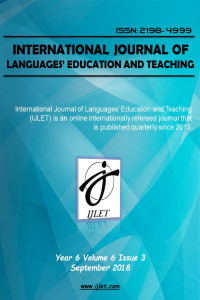Öz
Anahtar Kelimeler
Kaynakça
- Alcaraz-Marmol, G. (2009). Vocabulary input in EFL textbooks: Frequency levels. In Sanchez, A. & Cantos, P. (Eds.) A Survey on Corpus-based Research.Asociación Española de Lingüística del Corpus, pp. 771-783. Available at http://www.um.es/lacell/aelinco/contenido/pdf/52.pdf
- Alsaif, A. & Milton, J. (2012). Vocabulary input from school textbooks as a potential contributor to the small uptake gained by English as a foreign language learners in Saudi Arabia. The Language Learning Journal, 40(1), 21-33.
- Conklin, K. & Schmitt, N. (2008). Formulaic sequences: Are they processed more quickly than nonformulaic language by native and nonnative speakers?, Applied Linguistics, 29(1), 72–89.
- Criado, R. & Sanchez, A. (2009). Vocabulary in EFL textbooks: A contrastive analysis against three corpus-based ranges. In Sanchez, A. & Cantos, P. (Eds.) A Survey on Corpus-based Research.Asociación Española de Lingüística del Corpus, pp. 862-875. Available at http://www.um.es/lacell/aelinco/contenido/pdf/58.pdf
- Eurydice. (2017). Key Data on Teaching Languages at School in Europe – 2017 Edition. Eurydice Report. Luxembourg: Publications Office of the European Union. Retrieved from
- https://publications.europa.eu/en/publication-detail/-/publication/73ac5ebd-473e-11e7-aea8-01aa75ed71a1/language-en/format-PDF
- Fan, M. (2000). How big is the gap and how to narrow it? An investigation into the active and passive vocabulary knowledge of L2 learners. RELC Journal, 31(2), 105-119.
Öz
A lexical syllabus in a foreign language program is a first step in providing adequate input to L2 vocabulary as it dictates what goes into the course material. The present study evaluates the lexical component of the Turkish Education Ministry’s (MEB) English language syllabus for primary and middle grades revised in 2017. As the official MEB syllabus does not contain a separate vocabulary list, one was worked out in the present study from the MEB’s published English language programme document and the validity of the list was evaluated against other vocabulary lists as well as against findings of vocabulary research with other EFL learners. The comparison lists were Cambridge Young Learners Exams word lists (Starters, Movers, Flyers), word lists based on large English corpora of adult language users (BNC-COCA-25 lists) and children’s word lists based on oral language use of native-speaking English children (VP-Kids lists). The results have indicated rather poor coverage of native speaker word lists (both adults’ and children’s) by the MEB syllabus. The syllabus also envisaged a rather low input in terms of the number of words to be introduced to learners per class hour in comparison to the input received by EFL learners in other contexts. On the other hand, the list was at a comparable level with the Cambridge YLE lists with respect to overall size, but overlapped to a lesser extent in content. Only 60% of the words in YLE lists were covered in the MEB lists. The specification of clearer targets for grade levels and compilation of official vocabulary lists based on empirical data has been recommended.
Anahtar Kelimeler
Kaynakça
- Alcaraz-Marmol, G. (2009). Vocabulary input in EFL textbooks: Frequency levels. In Sanchez, A. & Cantos, P. (Eds.) A Survey on Corpus-based Research.Asociación Española de Lingüística del Corpus, pp. 771-783. Available at http://www.um.es/lacell/aelinco/contenido/pdf/52.pdf
- Alsaif, A. & Milton, J. (2012). Vocabulary input from school textbooks as a potential contributor to the small uptake gained by English as a foreign language learners in Saudi Arabia. The Language Learning Journal, 40(1), 21-33.
- Conklin, K. & Schmitt, N. (2008). Formulaic sequences: Are they processed more quickly than nonformulaic language by native and nonnative speakers?, Applied Linguistics, 29(1), 72–89.
- Criado, R. & Sanchez, A. (2009). Vocabulary in EFL textbooks: A contrastive analysis against three corpus-based ranges. In Sanchez, A. & Cantos, P. (Eds.) A Survey on Corpus-based Research.Asociación Española de Lingüística del Corpus, pp. 862-875. Available at http://www.um.es/lacell/aelinco/contenido/pdf/58.pdf
- Eurydice. (2017). Key Data on Teaching Languages at School in Europe – 2017 Edition. Eurydice Report. Luxembourg: Publications Office of the European Union. Retrieved from
- https://publications.europa.eu/en/publication-detail/-/publication/73ac5ebd-473e-11e7-aea8-01aa75ed71a1/language-en/format-PDF
- Fan, M. (2000). How big is the gap and how to narrow it? An investigation into the active and passive vocabulary knowledge of L2 learners. RELC Journal, 31(2), 105-119.
Ayrıntılar
| Birincil Dil | İngilizce |
|---|---|
| Konular | İkinci Bir Dil Olarak İngilizce |
| Bölüm | Araştırma Makalesi |
| Yazarlar | |
| Yayımlanma Tarihi | 30 Eylül 2018 |
| Yayımlandığı Sayı | Yıl 2018 Cilt: 6 Sayı: 3 |

